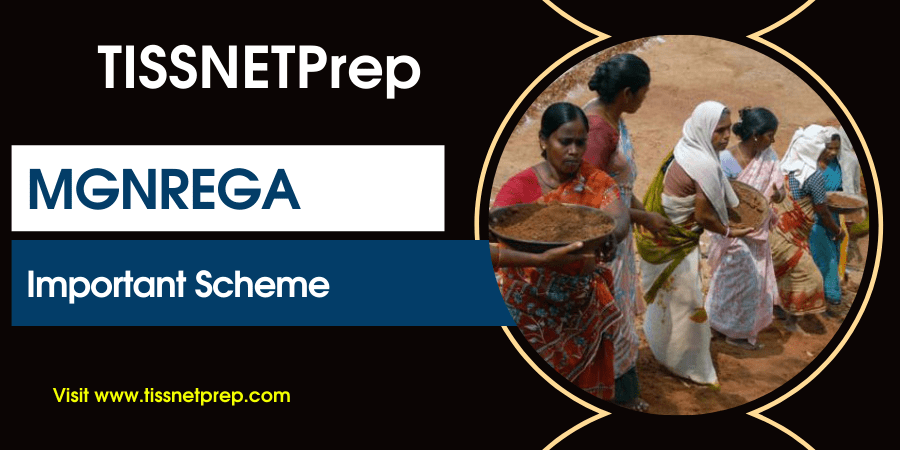The Union government has allocated Rs.72000 crores for The Mahatma Gandhi National Rural Employment Guarantee Act, (MGNREGA) scheme in 2021-22.
Quick Facts about MGNREGA 2022:
| MGNREGA Full Form | Mahatma Gandhi National Rural Employment Guarantee Act |
| When the MGNREGA Scheme officially launched? | 2nd February 2006The Mahatma Gandhi National Rural Employment Guarantee Act was passed on 23rd August 2005 |
| What was MGNREGA earlier called? | It was known to be National Rural Employment Guarantee Act |
| Are MGNREGS and MGNREGA the same? | MGNREGS is a scheme which is based on the MGNREGA (Act) |
| Number of Districts covered under the MGNREGA Scheme? | As of 11th February 2021; 708 districts are covered |
| Key Stakeholders under MGNREGA | Wage seekersGram Sabha (GS)Three-tier Panchayati Raj Institutions (PRIs)Programme Officer at the Block levelDistrict Programme Coordinator (DPC)State GovernmentMinistry of Rural Development (MoRD)Civil SocietyOther stakeholders (In line departments, convergence departments, Self-Help Groups (SHGs) |
| What is MGNREGA Job Card? | It is a document that renders a worker entitled for work under the MGNREGA Scheme |
| Mandate of Mahatma Gandhi NREGS | Provision of at least 100 days of work that provides guaranteed wage in a financial year |
| MGNREGA Official Website | https://nrega.nic.in/netnrega/home.aspx |
MGNREGA & Workers Crisis – COVID Pandemic
Finance Minister Nirmala Sitharaman on March 26th, 2020, the workers under the MGNREGA would get a hike of Rs. 2000 each on an average. It was also announced that three crore senior citizens, persons with disabilities, and widows will get a one-time additional amount of Rs 1,000 in two installments which will be provided through DBT (Direct Benefit Transfer) over three months. This announcement was made as an initiative towards the loss caused by the Covid-19 outbreak. The 21 days lockdown was expected to cost the Indian Economy a cost of around 9 lakh crores. Funds worth Rs 31,000 crore are also to be provided to augment medical testing, screening, and providing better healthcare facilities to those who have been affected financially due to the Covid-19 outbreak.
MGNREGA History:
In 1991, the P.V Narashima Rao government proposed a pilot scheme for generating employment in rural areas with the following goals:
- Employment Generation for agricultural labour during the lean season.
- Infrastructure Development
- Enhanced Food Security
This scheme was called the Employment Assurance Scheme which later evolved into the MGNREGA after the merger with the Food for Work Programme in the early 2000s.
Objectives of MGNREGA:
The Mahatma Gandhi National Rural Employment Guarantee Act (MGNREGA) has the following objectives:
- Provide 100 days of guaranteed wage employment to rural unskilled labour
- Increase economic security
- Decrease migration of labour from rural to urban areas
MGNREGA differentiates itself from earlier welfare schemes by taking a grassroots-driven approach to employment generation. The programs under the act are demand-driven and provide legal provisions for appeal in the case, work is not provided or payments are delayed. The scheme is funded by the central government which bears the full cost of unskilled labour and 75% of the cost of material for works undertaken under this law. The central and state governments audit the works undertaken under this act through annual reports prepared by CEGC (Central Employment Guarantee Council) and the SEGC (State Employment Guarantee Councils). These reports have to be presented by the incumbent government in the legislature.
A few salient features of the scheme are:
- It gives a significant amount of control to the Gram Panchayats for managing public works, strengthening Panchayati Raj Institutions. Gram Sabhas are free to accept or reject recommendations from Intermediate and District Panchayats.
- It incorporates accountability in its operational guidelines and ensures compliance and transparency at all levels.
Ever since the scheme was implemented, the number of jobs has increased by 240% in the past 10 years. The scheme has been successful in enhancing economic empowerment in rural India and helping overcome the exploitation of labour. The scheme has also diminished wage volatility and the gender pay gap in labour. This can be substantiated the by the following data available at the official site of MGNREGA:
- 14.88 crores MGNREGA job cards have been issued (Active Job Cards – 9.3 crores)
- 28.83 crores workers who gained employed under MGNREGA (2020-21) out of which active workers are 14.49 crores.
What is the role of Gram Sabha and Gram Panchayat in MGNREGS?
The role of Gram Sabha in the Mahatma Gandhi National Rural Employment Guarantee Scheme is tabled below:
| Role of Gram Sabha in MGNREGS |
| It lists down the works priority-wise w.r.t the potential of the local area |
| It monitors the work executed within the Gram Panchayat |
| It acts as the primary forum for the social audits |
| It also works as a platform to resolve all workers’ queries related to any MGNREGA work |
The role of Gram Panchayat in the Mahatma Gandhi National Rural Employment Guarantee Scheme is tabled below:
| Role of Gram Panchayat |
| It is authorized with the role to receive the job applications |
| After receiving the applications, it is responsible to verify them |
| All household are registered by the Gram Panchayat |
| The MGNREGS job cards are issued by the Gram Panchayat |
| It is responsible to allot work within 15 days from the application submission |
| It prepares an annual report that covers the achievement of the scheme |
| It holds Rozgar Diwas at every ward once a month |
Role of State Governments in MGNREGS
The important roles of the state government in executing the MGNREGA scheme are:
- It frames rules charting out state’s responsibility under the act.
- It sets up the State Employment Guarantee Council.
- State Employment Guarantee Fund (SEGF) is established by state governments.
- It makes sure to dedicate Employment Guarantee Assistant (Gram Rozgar Sahayak), the PO and the staff at State, district, cluster and Gram Panchayat level; for the execution of the scheme.
MGNREGA – State Employment Guarantee Council (SEGC)
The State Employment Guarantee Council is responsible to advise state government for the implementation of the MGNREG scheme. Some important functions of SEGC under MNREGS are:
- The suggestion of improvements in the execution of the scheme.
- Evaluation and monitoring of the scheme.
- To recommend proposals of the works to the central government.
- To aware the districts about the scheme and its features.
- To prepare an annual report to be submitted by the state government before the state legislature.

